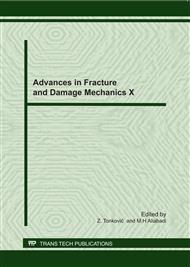p.1
p.5
p.9
p.13
p.17
p.21
p.25
p.29
p.33
Fracture Analysis of a First Stage Turbine Blade by FRANC3D
Abstract:
The premature failure of a blade occurred after a service life of 8127 EOH operation houre. This paper presents the fracture analysis of the first stage blade through fractographic and mechanical analysis. Crack growth mechanisms were evaluated based on the microscopic observations of the fracture surfaces by SEM. The analysis of the different region of the fracture surface shows that crack propagation is mainly related with fatigue mechanism. The crack propagation occurred in the pressure-suction side direction. The dynamic characteristics of the blade were evaluated by FEM in order to identify the cause of blade failure. The result depicts that the second mode of vibration might be excited and the vibratory stresses cause to HCF damage of the blade. Eventully fracture analysis of the blade under the presence of a fatigue crack was analyzed by FRACNC3D software.
Info:
Periodical:
Pages:
17-20
Citation:
Online since:
September 2011
Authors:
Keywords:
Price:
Сopyright:
© 2012 Trans Tech Publications Ltd. All Rights Reserved
Share:
Citation:


